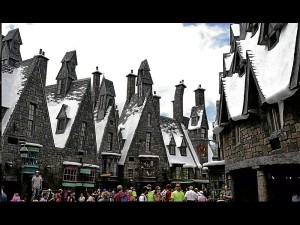
THE ‘WIZARDING World of Harry Potter’ best enjoyed momentarily for the very ‘real’ alternative world it provides. But themed communities are best left to theme parks and recreational facilities. Real communities have to provide much more than artificial marketing, and need to cater to real and lifestyle requirements.
It was like walking into a parallel universe. This was after all, Hogwarts. Nonexistent in the real world but existent in the minds of the diehard “Potterheads” and the not so die-hard ones like myself, who walked into the “Wizarding World of Harry Potter” to enjoy the enchantment of twisted gothic structures, sorcery, witchcraft and all things of wizardry. What the uber-imaginative JK Rowling put together in her mind was right here. Tangible.
“Wizarding World” was like a little village, quite unlike the other “village” attractions in the theme park we visited, for it was, in the smallest of details, a faithful recreation of the little dark yet magical villages of Potter-dom. The attention to detail in the architectural recreation of the village—and in the final finish of all “props” visible—held true to Rowling’s Hogwarts imaginings. And in this place, it all looked so real!
Fail to deliver
Which isn’t the same thing we can say about the many themed villages or communities many developers try to package and sell in the country. Tangible? Yes. Real? No.
The trouble with themed communities is not so much how outdated most of their themes are, but rather in how much of the experience of being there in that otherworld, they actually fail to deliver. The charm about entering any themed community lies in being transported into another world that you may not have the luxury of time or money to visit. So why even bother to “theme” it, and try to make it look like some other place, when its recreation cannot be executed faithfully. We have many places with fancy names that don’t look at all like the place they call or claim themselves to be like.
I remember when Tagaytay Highlands, the high-end golf resort on the ridge, started to fill up in the late 1990s. People liked to joke that it was like entering a theme park.
While others found it kitschy, I stood by the thrill that it was pretty true to what it was trying to deliver: its China Palace was authentic Chinese (yes, from food to premises), with the entire structure made and shipped in from China; the log homes were solid cedar log homes (no cheating there) designed closely with their Canadian suppliers to deliver authentic log homes; and their Italian Villas stood by the more traditional layout and sizes, even if they were a bit of a deviation from what the typical Filipino was used to.
Even the landscaping in their various communities tied in with the themes. In other words, they managed to create an alternative. It succeeded as “another world.”
Which is not what we can say for most other themed communities here. While the concepts are designed to follow certain design features—the Mediterranean possibly being the most popular—most of these communities have been developed in a very artificial way. The Spanish, Italian and French Mediterranean concepts are very marketable, probably because the Mediterranean coast and the Tuscan hills offer some of the world’s prettiest sights.
But housing developments following the path of the original locales hardly fall into the category of “pretty”—for they are often contrived in a very man-made way, looking like bad hybrids of Italianate and Filipino (or French and Filipino, or Spanish and Filipino).
Aside from a rawness and oddness in the way they are finished, there is also the shortfall in following the true proportions and details, that are brought about by local conditions, and that make a structure’s configuration and design details distinct to its style or context. It is very difficult, and costly, to recreate something that as not inherently grown out from its own environment.
A lot of resistance
What developers should offer in their communities should be a design and infrastructure that supports a certain lifestyle rather than a certain “look.” On the long term, any particular theme cannot be sustained, and that is evident in older themed communities where eventually, residents renovate and deviate from the original design concepts. In fact, many of the newer themed communities get a lot of resistance because residents would like to express their very personal aesthetic preferences.
Theming a community in terms of design is artificial and will not thrive on the long term. Perhaps developers have to look at the greater and more essential needs of their buyer profile in order to have something more substantial to offer.
Themed communities are best left to theme parks. Only a handful has gotten away with themed communities, and theirs is really a tough act to follow.
Contact the author through designdimensions@abi.ph or through our Asuncion Berenguer Facebook account.

